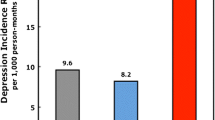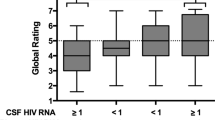Abstract
Depression is a common illness in people with HIV (PWH) and is associated with substantial morbidity and mortality. The mechanisms that underpin depression in PWH remain incompletely elucidated, and more research is therefore needed to develop effective treatments. One hypothesis is that neurotransmitter levels may be altered. These levels could be influenced by the chronic inflammation and viral persistence that occurs in PWH. We examined a panel of cerebrospinal fluid (CSF) neurotransmitters in PWH on suppressive antiretroviral therapy (ART), many of whom had a current depression diagnosis. CSF monoamine neurotransmitters and their metabolites were measured from participants in studies at the Emory Center for AIDS Research (CFAR). Only participants on stable ART with suppressed HIV RNA from both plasma and CSF were analyzed. Neurotransmitter levels were measured with high-performance liquid chromatography (HPLC). Neurotransmitters and their metabolites included dopamine (DA), homovanillic acid (HVA, a major metabolite of dopamine), serotonin (5-HT), 5-hydroxyindole-3-acetic acid (5-HIAA, a major metabolite of serotonin), and 4-hydroxy-3-methoxyphenylglycol (MHPG, a major metabolite of norepinephrine). Multivariable logistic regression was used to evaluate factors associated with depression. There were 79 PWH with plasma and CSF HIV RNA levels < 200 copies/mL at the time of the visit, and 25 (31.6%) carried a current diagnosis of depression. Participants with depression were significantly older (median age 53 years versus 47 years, P = 0.014) and were significantly less likely to be African American (48.0% versus 77.8%, P = 0.008). Participants with depression had significantly lower dopamine levels (median 0.49 ng/mL versus 0.62 ng/mL, P = 0.03) and significantly lower 5-HIAA levels (median 12.57 ng/mL versus 15.41 ng/mL, P = 0.015). Dopamine and 5-HIAA were highly correlated. In the multivariable logistic regression models, lower 5-HIAA was significantly associated with the depression diagnosis when accounting for other significant demographic factors. The associations between lower 5-HIAA, lower dopamine, and depression in PWH suggest that altered neurotransmission may contribute to these comorbid conditions. However, the effects of antidepressants on neurotransmitters cannot be ruled out as a factor in the 5-HIAA results.

Similar content being viewed by others
Data availability
Study data may be provided on request.
References
Anderson AM, Bhondoekhan F, Curanovic D et al (2022) Higher soluble CD163 in blood is associated with significant depression symptoms in men with HIV. Journal of Acquired Immune Deficiency Syndromes (JAIDS)
Bailey RK, Patel M, Barker NC, Ali S, Jabeen S (2011) Major depressive disorder in the African American population. J Natl Med Assoc 103:548–557
Bejamini YHY (1995) Controlling the false discovery rate: a practical and powerful approach to multiple testing. J Royal Stat Soc Series B (Methodological) 257:289–300
Bennett BA, Rusyniak DE, Hollingsworth CK (1995) HIV-1 gp120-induced neurotoxicity to midbrain dopamine cultures. Brain Res 705:168–176
Berger JR, Kumar M, Kumar A, Fernandez JB, Levin B (1994) Cerebrospinal fluid dopamine in HIV-1 infection. AIDS 8:67–71
Carpenter LL, Anderson GM, Siniscalchi JM, Chappell PB, Price LH (2003) Acute changes in cerebrospinal fluid 5-HIAA following oral paroxetine challenge in healthy humans. Neuropsychopharmacology 28:339–347
Cook JA, Burke-Miller JK, Steigman PJ et al (2018) Prevalence, comorbidity, and correlates of psychiatric and substance use disorders and associations with HIV risk behaviors in a multisite cohort of women living with HIV. AIDS Behav 22:3141–3154
Cysique LA, Franklin D Jr, Abramson I et al (2011) Normative data and validation of a regression based summary score for assessing meaningful neuropsychological change. J Clin Exp Neuropsychol 33:505–522
De Bellis MD, Geracioti TD Jr, Altemus M, Kling MA (1993) Cerebrospinal fluid monoamine metabolites in fluoxetine-treated patients with major depression and in healthy volunteers. Biol Psychiatry 33:636–641
Do AN, Rosenberg ES, Sullivan PS et al (2014) Excess burden of depression among HIV-infected persons receiving medical care in the united states: data from the medical monitoring project and the behavioral risk factor surveillance system. PLoS ONE 9
Ellis RJ, Letendre SL, Atkinson JH et al (2020) Higher levels of plasma inflammation biomarkers are associated with depressed mood and quality of life in aging, virally suppressed men, but not women, with HIV. Brain Behav Immun Health 7
Gallant J, Hsue PY, Shreay S, Meyer N (2017) Comorbidities among US patients with prevalent HIV infection-a trend analysis. J Infect Dis 216:1525–1533
Global Burden of Disease Study C (2015) Global, regional, and national incidence, prevalence, and years lived with disability for 301 acute and chronic diseases and injuries in 188 countries, 1990–2013: a systematic analysis for the Global Burden of Disease Study 2013. Lancet 386:743–800
Group ISS, Lundgren JD, Babiker AG et al (2015) Initiation of antiretroviral therapy in early asymptomatic HIV infection. N Engl J Med 373:795–807
Heaton RK, Miller SW, Taylor MJ, Grant I (2004) Revised comprehensive norms for an expanded Halstead-Reitan battery: demographically adjusted Europsycho-logical norms for African American and Caucasian adults scoring program
Horberg MA, Silverberg MJ, Hurley LB et al (2008) Effects of depression and selective serotonin reuptake inhibitor use on adherence to highly active antiretroviral therapy and on clinical outcomes in HIV-infected patients. J Acquir Immune Defic Syndr 47:384–390
Ickovics JR, Hamburger ME, Vlahov D et al (2001) Mortality, CD4 cell count decline, and depressive symptoms among HIV-seropositive women: longitudinal analysis from the HIV Epidemiology Research Study. JAMA, J Am Med Assoc 285:1466–1474
Jayamohananan H, Manoj Kumar MK (2019) T PA 5-HIAA as a potential biological marker for neurological and psychiatric disorders. Adv Pharm Bull 9:374–81
Kacanek D, Jacobson DL, Spiegelman D, Wanke C, Isaac R, Wilson IB (2010) Incident depression symptoms are associated with poorer HAART adherence: a longitudinal analysis from the Nutrition for Healthy Living study. J Acquir Immune Defic Syndr 53:266–272
Kahn RS, Davidson M, Knott P, Stern RG, Apter S, Davis KL (1993) Effect of neuroleptic medication on cerebrospinal fluid monoamine metabolite concentrations in schizophrenia. Serotonin-dopamine interactions as a target for treatment. Arch Gen Psych 50:599–605
Kumar AM, Berger JR, Eisdorfer C, Fernandez JB, Goodkin K, Kumar M (2001) Cerebrospinal fluid 5-hydroxytryptamine and 5-hydroxyindoleacetic acid in HIV-1 infection. Neuropsychobiology 44:13–18
Kumar AM, Fernandez JB, Singer EJ et al (2009) Human immunodeficiency virus type 1 in the central nervous system leads to decreased dopamine in different regions of postmortem human brains. J Neurovirol 15:257–274
Larsson M, Hagberg L, Forsman A, Norkrans G (1991) Cerebrospinal fluid catecholamine metabolites in HIV-infected patients. J Neurosci Res 28:406–409
Mitchell AJ, Vaze A, Rao S (2009) Clinical diagnosis of depression in primary care: a meta-analysis. Lancet 374:609–619
Musinguzi K, Obuku A, Nakasujja N et al (2018) Association between major depressive disorder and pro-inflammatory cytokines and acute phase proteins among HIV-1 positive patients in Uganda. BMC Immunol 19:1
Norcini Pala A, Steca P, Bagrodia R et al (2016) Subtypes of depressive symptoms and inflammatory biomarkers: an exploratory study on a sample of HIV-positive patients. Brain Behav Immun 56:105–113
Ogawa S, Tsuchimine S, Kunugi H (2018) Cerebrospinal fluid monoamine metabolite concentrations in depressive disorder: a meta-analysis of historic evidence. J Psychiatr Res 105:137–146
Owens MJ, Nemeroff CB (1994) Role of serotonin in the pathophysiology of depression: focus on the serotonin transporter. Clin Chem 40:288–295
Pence BW, Mills JC, Bengtson AM et al (2018) Association of increased chronicity of depression with HIV appointment attendance, treatment failure, and mortality among HIV-infected adults in the United States. JAMA Psychiat 75:379–385
Poudel-Tandukar K, Bertone-Johnson ER, Palmer PH, Poudel KC (2014) C-reactive protein and depression in persons with human immunodeficiency virus infection: the Positive Living with HIV (POLH) Study. Brain Behav Immun 42:89–95
Riolo SA, Nguyen TA, Greden JF, King CA (2005) Prevalence of depression by race/ethnicity: findings from the National Health and Nutrition Examination Survey III. Am J Public Health 95:998–1000
Robertson K, Yosief S (2014) Neurocognitive assessment in the diagnosis of HIV-associated neurocognitive disorders. Semin Neurol 34:21–26
Roy A, De Jong J, Linnoila M (1989) Cerebrospinal fluid monoamine metabolites and suicidal behavior in depressed patients. A 5-year follow-up study. Arch Gen Psych 46:609–12
Rubin LH, Maki PM (2019) HIV, depression, and cognitive impairment in the era of effective antiretroviral therapy. Curr HIV/AIDS Rep 16:82–95
Saloner R, Cherner M, Grelotti DJ et al (2020) Lower CSF homovanillic acid relates to higher burden of neuroinflammation and depression in people with HIV disease. Brain Behav Immun 90:353–363
Scheepers FE, Gispen-de Wied CC, Westenberg HG, Kahn RS (2001) The effect of olanzapine treatment on monoamine metabolite concentrations in the cerebrospinal fluid of schizophrenic patients. Neuropsychopharmacology 25:468–475
Scheller C, Sopper S, Jenuwein M et al (2005) Early impairment in dopaminergic neurotransmission in brains of SIV-infected rhesus monkeys due to microglia activation. J Neurochem 95:377–387
Shah S, Sinharay S, Matsuda K et al (2019) Potential mechanism for HIV-associated depression: upregulation of serotonin transporters in SIV-infected macaques detected by 11C-DASB PET. Front Psych 10:362
Sheline Y, Bardgett ME, Csernansky JG (1997) Correlated reductions in cerebrospinal fluid 5-HIAA and MHPG concentrations after treatment with selective serotonin reuptake inhibitors. J Clin Psychopharmacol 17:11–14
Sin NL, DiMatteo MR (2014) Depression treatment enhances adherence to antiretroviral therapy: a meta-analysis. Ann Behav Med 47:259–269
Song CH, Fan X, Exeter CJ, Hess EJ, Jinnah HA (2012) Functional analysis of dopaminergic systems in a DYT1 knock-in mouse model of dystonia. Neurobiol Dis 48:66–78
Strategies for Management of Antiretroviral Therapy Study G, El-Sadr WM, Lundgren J et al (2006) CD4+ count-guided interruption of antiretroviral treatment. The New England J Med 355:2283–96
United States Department of Health and Human Services (2022) Guidelines for the use of antiretroviral agents in adults and adolescents with HIV. https://clinicalinfo.hiv.gov/en/guidelines. Accessed 30 Nov 2022
Vlassova N, Angelino AF, Treisman GJ (2009) Update on mental health issues in patients with HIV infection. Curr Infect Dis Rep 11:163–169
Williams DR, Gonzalez HM, Neighbors H et al (2007) Prevalence and distribution of major depressive disorder in African Americans, Caribbean blacks, and non-Hispanic whites: results from the National Survey of American Life. Arch Gen Psychiatry 64:305–315
Funding
The authors gratefully acknowledge funding R01AG062387, R01MH128872, and R01MH128158, as well as P30AI050409 (Emory Center for AIDS Research).
Author information
Authors and Affiliations
Corresponding author
Ethics declarations
Conflict of interest
The authors declare no competing interests.
Additional information
Publisher's Note
Springer Nature remains neutral with regard to jurisdictional claims in published maps and institutional affiliations.
Rights and permissions
Springer Nature or its licensor (e.g. a society or other partner) holds exclusive rights to this article under a publishing agreement with the author(s) or other rightsholder(s); author self-archiving of the accepted manuscript version of this article is solely governed by the terms of such publishing agreement and applicable law.
About this article
Cite this article
Fu, R., Jinnah, H., Mckay, J.L. et al. Cerebrospinal fluid levels of 5-HIAA and dopamine in people with HIV and depression. J. Neurovirol. 29, 440–448 (2023). https://doi.org/10.1007/s13365-023-01142-2
Received:
Revised:
Accepted:
Published:
Issue Date:
DOI: https://doi.org/10.1007/s13365-023-01142-2




